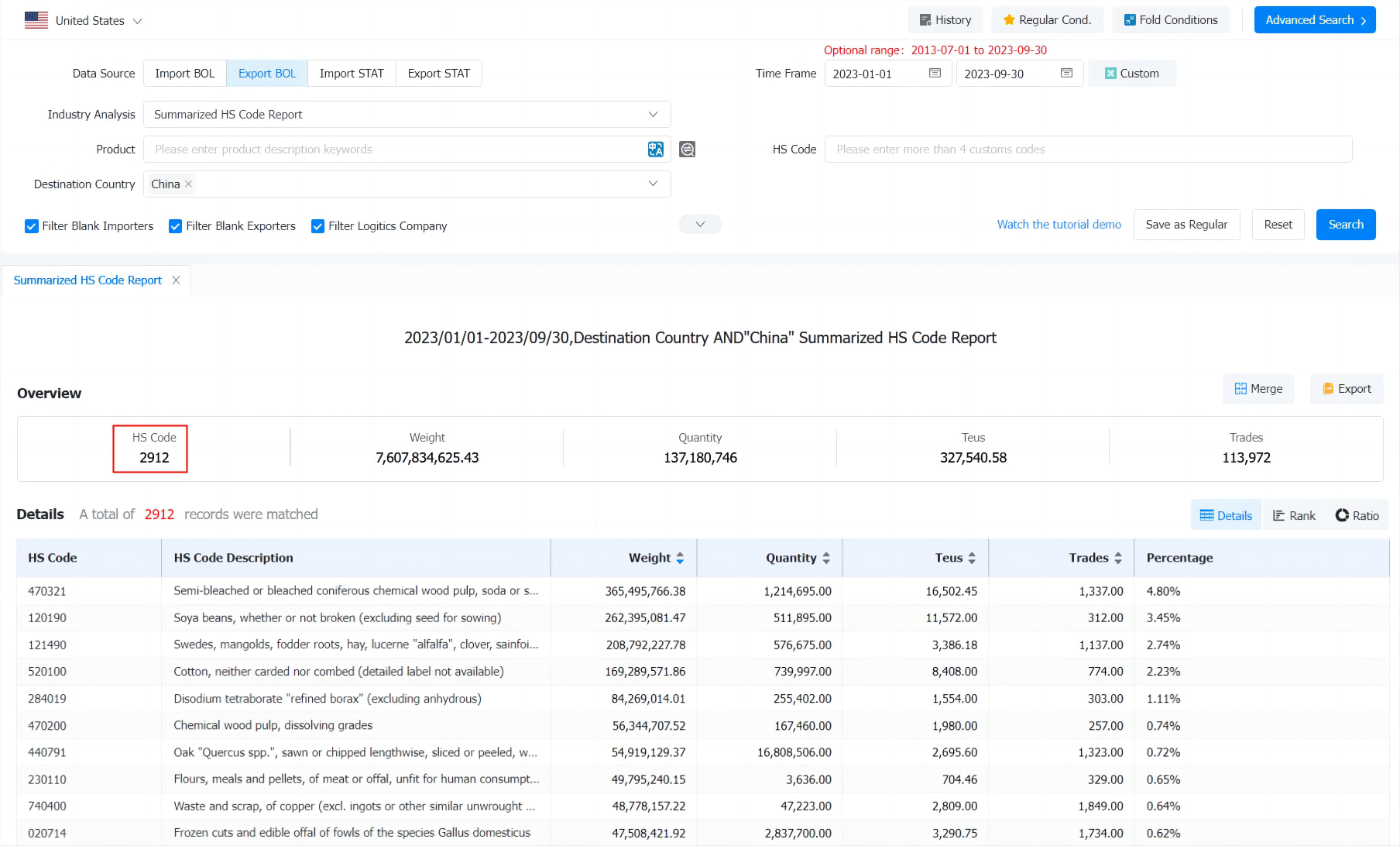 Export News
Export News
 05-12-2023
05-12-2023
The trade relationship between the United States and China is a crucial
aspect of the global economy. Examining the products the U.S. exports to China
provides valuable insights into the dynamics of international trade. In this
article, Tendata will delve into the current status of U.S. exports to China,
analyzing key products and trends shaping this significant economic
relationship.

1. Semi-Bleached or Bleached Coniferous Chemical Wood Pulp (HS Code: 470321)
The export of semi-bleached or bleached coniferous chemical wood pulp is a notable component of U.S.-China trade. This product, classified under HS Code 470321, holds a substantial share in the export market. The demand for quality pulp materials in China's paper and packaging industry contributes significantly to this trade flow.
2. Soya Beans (HS Code: 120190)
Soybeans, a versatile and widely consumed commodity, hold a prominent position in U.S. exports to China. The trade dynamics of soya beans, categorized under HS Code 120190, are influenced by various factors, including agricultural policies, global market conditions, and geopolitical considerations.
3. Swedes, Mangolds, and Forage Products (HS Code: 121490)
The export of swedes, mangolds, and other forage products plays a vital role in supporting China's livestock and agriculture sectors. Categorized under HS Code 121490, these products contribute to the nutritional needs of livestock and serve as essential components in animal feed formulations.
4. Cotton (HS Code: 520100)
Cotton, a fundamental textile raw material, forms a substantial part of U.S. exports to China. Under HS Code 520100, this export contributes to China's vibrant textile and apparel industry, reflecting the intricate threads of economic interdependence between the two nations.
5. Chemical Wood Pulp, Dissolving Grades (HS Code: 470200)
The export of chemical wood pulp with dissolving grades, categorized under HS Code 470200, represents a niche but significant aspect of U.S.-China trade. These specialized grades of pulp find applications in various industries, including textiles, pharmaceuticals, and specialty chemicals.
Conclusion:
The U.S. export landscape to China is diverse and dynamic, encompassing a range of products from pulp and agricultural commodities to industrial materials. Understanding the trends and intricacies of this trade relationship is crucial for businesses, policymakers, and industry stakeholders. As both nations navigate evolving economic landscapes, adapting to changes in consumer preferences, sustainability requirements, and geopolitical factors will be pivotal for fostering a resilient and mutually beneficial trade partnership. The intricate web of U.S. exports to China reflects not only economic ties but also the broader tapestry of globalization and interdependence in the contemporary world.
>>>Click to Get Free Access to Customs Data from 80+ Countries<<<
Is Free Customs Data Useful?
Currently, customs data in the market is divided into two categories: paid and free. According to Tendata's knowledge, many customs data companies claim to have developed a free customs data system. However, the core intention is to attract traffic for secondary marketing and profit.

Shanghai Tendata iTrader provides detailed customs data inquiries from 80+ countries, (>>>Click to Use Data Analytics for Free Online) statistical data inquiries from 27 EU countries, millions of genuine and accurate purchaser information, and detailed information on successful client bill of ladings. With its system capable of generating 17 types of market data analysis reports with a single click, Tendata iTrader assists management in making informed decisions effortlessly.
Category
Leave Message for Demo Request or Questions


 T-info
T-info T-discovery
T-discovery

 My
Tendata
My
Tendata Market Analysis
Market Analysis Customer
Development
Customer
Development Competitor
Monitoring
Competitor
Monitoring Customer Relationship
Customer Relationship





































































































































